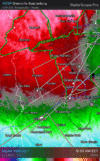GSP
As of 655 am EST Tuesday: Our event is well underway at this hour,
with precip covering nearly the entire forecast area. The table has
been set for a busy day. We have a number of problems to discuss,
so let`s get right to it.
Changes for this update include an expansion of
thunder to cover
most of the area east of the
mtns right away this morning. Elevated
instability was doing the trick across north GA early this morning
and that trend has continued into northeast GA and the western
Upstate. The main severe threat still appears to be this afternoon,
however. A new Wind Advisory was issued for the mountains to take
care of the very strong wind gusts on the cold
advection side
of the system after it departs tonight. There is a gap of time
during which the wind will be in a lull. The wind picks up again
from the west during the mid/late evening and will continue from
that direction into Wednesday morning.
Otherwise...the best precip rates have been over the southerly
upslope areas of northeast GA/western Upstate SC/southern
mtns
of
NC, more or less where we expected early in the event, with
amounts starting to add up. This was soaking down the area and
priming it for problems later on this morning when even heavier
rain seen
upstream over north GA and eastern AL gets here thru
late morning. The latest
QPF from WPC has come down just a bit, as
have the 6hr prob matched
mean precip on the 00Z run of the HREF,
but what remains is still more than adequate to support keeping the
Flood Watch intact. We could contemplate putting Graham and Swain
in there as well, but at this point it is probably academic. The
lower Piedmont of SC/Lakelands remains out of the
Watch, but that
still looks ok. No changes to the
Flood Watch.
As for the
Winter Weather Advisory, there may still be a few
isolated pockets of near freezing temps close to the Blue
Ridge
Escarpment north of I-40, but the continued gradual warming across
the nrn mountains/foothills should have taken care of what`s left
in very short order. Thus, we will let the Advisory go on schedule.
As for the Wind situation, it has been somewhat underwhelming
thus far as the strongest winds have been riding up over the
very shallow
stable layer across the
mtns. However, the higher
peaks are gradually encountering the stronger winds and the gusts
have been creeping upward. Think we are still on track early this
morning. Guidance suggests we will start to mix deeply enough over
the lower Piedmont starting around 15Z to bring frequent wind gusts
of 40-45kt or so down to the ground. The
wind gust potential should
then spread northward thru the rest of the morning and into the
afternoon as we uncover more of the
fcst area. Guidance suggest
the winds will persist into tonight. More on that later.
The other primary concern is the
severe thunderstorm potential. Only
minor changes were made to the new Day 1
Outlook from
SPC and that
seems reasonable. Clearly the potential looks better to our S and E
this afternoon and evening, but we still have a good shot at severe
storms. The
synoptic scale models bring a plume of low
sfc-based
CAPE of 300-500
J/kg across the area along/SE of I-85 from late
morning thru late afternoon ahead of the
sfc front, to go along
with what looks like very strong
shear. The pattern resembles many
high
shear/low
CAPE severe weather episodes we have seen over the
years, with a
dry punch coming in behind a very strongly forced
sfc
boundary. The CAMs in the 00Z HREF do not disappoint, with most
showing some
updraft helicity streaks over the area from AND to
GSP to HKY and points east...basically where the plume of weak
CAPE
would reach. This checks just about all the boxes for a severe wind
producing
squall line across that area, with occasional brief/weak
tornadoes where the line breaks or where embedded
meso-vortices
persist. Such brief tornadic circulations are notoriously difficult
to warn with much lead time. Expect part of the area will end up in
some sort of
SVR/
TOR Watch at some point this afternoon, so be on
the lookout for that. The severe weather threat/additional flooding
threat will end from the west with the passage of the main
front.
Tonight, with the
front to the east, colder air will move in that
should change any remaining precip over the
mtns over to snow
showers thru the mid/late evening. The
flow looks unconventional
as it veers from SW to W overnight, but there is enough
moisture
that is deep enough into the
dendritic growth zone such that
snow showers are a good bet. The westerly
flow favors parts of
the Smokies, in particular western Graham County. We may need
to consider a small
Winter Weather Advisory depending on how the
forecast trend
goes today.
Wind will continue to be a problem tonight, particularly over
the
mtns as the cold
advection flow takes hold. Guidance has
strong wind gusts persisting through Wednesday morning, so a Wind
Advisory will be issued/extended across the higher terrain through
18Z Wednesday. East of the
mtns, it will also be
blustery, but
not to the extent that an Advisory is warranted, but this could
also change.






